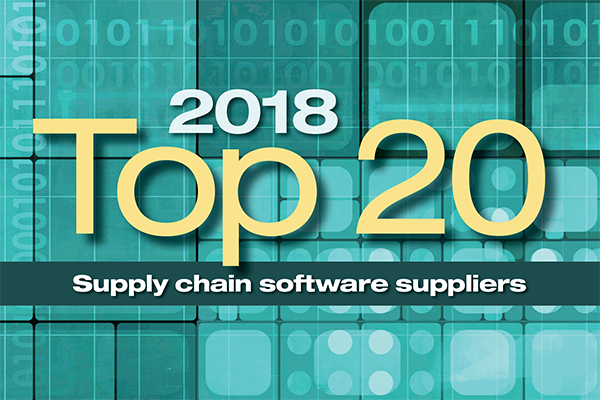2018 Top 20 supply chain software suppliers

While the top of the list remains stable, up-and-comers are mixing up the software landscape with Cloud capabilities that traditional vendors are working to replicate.
The adoption of supply chain management (SCM) software grew significantly in 2017, according to research firm Gartner, and the growth is reflected in the performance of the Top 20 vendors in the space. Gartner’s list follows its report that total worldwide market revenue grew 13.9% to reach a total of $12.2 billion last year.
Balaji Abbabatulla, research director at Gartner, says Cloud capabilities are driving much of the growth.
He estimates a 50/50 split between top vendors who develop these capabilities organically and those who have acquired companies with Cloud expertise. Key benefits of Cloud-based software include low up-front cost, eliminating the need for large in-house IT teams, and automatic updates.
“However, increasing adoption levels are not just about the Cloud for the sake of itself, but about business value,” Abbabatulla says. “End-users are no longer happy to wait years to achieve real, functional value. Instead, they are happy to compromise on a set of features to incrementally improve right now. It might not be as optimal, but at least something gets rolling.”
Abbabatulla says the shift in defining the value of Cloud software is meaningful and has prompted vendors to approach the market differently. Today, he says, most Cloud solutions offered by traditional suppliers are not as robust as on-premise deployments, but nearly all leading vendors have a program in place to bring Cloud deployments to the same level of performance.
“They’re slowly getting there, but the conversation has already moved, in my mind,” he adds. “There is much less concern about security and latency, and more about maintaining software and features. It seems to be the direction vendors are moving because end-users are concerned about software management. The key value is when it’s seamless for the end-user to add functionality quickly and easily.”
Top 20 Supply Chain Management Software Suppliers
The view from the top
The top five vendors in the SCM market all increased revenue, but only JDA and Infor grew market share by outperforming the total market growth, Abbabatulla says. “The ‘other vendors’ category is growing significantly faster than the top five market incumbents,” he says, “but the top five rankings remained the same in 2017.”
The next five on the list, he adds, are a different story. WiseTech, which joined the list last year, is an Australia-based software supplier that is expanding in Europe and Latin America and, to a lesser extent, the United States.
“They’re serving smaller and mid-sized companies, and have now built a core platform and model of onboarding that allows them to grow,” Abbabatulla says. “Closer to home, Descartes, which has a legacy of acquisition, has been able to leverage complementary strengths.”
SCP total software revenue
Challenges are on the horizon for all vendors, Abbabatulla cautions, as they continue to add functionality related to emerging technologies. As new technology comes on the scene, he says, it will take some time for the hype to fade and mature into better value.
“Pretty much every software vendor has to incorporate these new technologies, whether it’s natural language processing, machine learning, Internet of Things (IoT), robotics, you name it,” Abbabatulla says. “Vendors are trying to learn these technologies as fast as they can and then incorporate them into their solution. This is a learning process, and there is so much change happening that there will be some change in the market’s growth rate. From 12% or so for several years and 13% last year, it will likely drop to about 9% in coming years.”
What’s in store
Globally, Abbabatulla says emerging markets will help sustain growth in coming years due to ongoing adoption of more fundamental software solutions like warehouse management systems (WMS) and transportation management systems (TMS). Few large organizations in North America and Western Europe don’t use some form of WMS or TMS, he says. In emerging economies, which make up roughly half of the overall market, there isn’t a mature legacy of such software. Differences exist in the business models, too. These companies tend to have customers tied into long-term contracts, Abbabatulla says, so to switch to a new platform brings different costs and concerns.
Small- and medium-sized businesses are poised to benefit from a renewed vendor focus on solutions for such organizations. Even large enterprises are increasingly building smaller facilities and network nodes. The resulting solutions, when delivered by the Cloud, can grant small businesses with outsized software sophistication.
“Traditionally, supply chain applications were used for large enterprises and all the technology was built around those metrics,” Abbabatulla says. “It’s shifting slowly to solutions that work in a mid-sized software environment. This enables that segment to respond to things like the Amazon Effect. Mid-sized businesses are one of the key segments needing the flexibility and agility to compete and, with these supply chain software solutions, they can.”
SCE total software revenue
Inside the numbers
Market leaders in the overall category of supply chain management continued to dominate the market in 2017, with the top five providers accounting for 49% of the total market.
The individual market segments also posted impressive gains. Supply chain execution systems, which includes WMS and TMS, grew 13% to $3.87 billion. Once again, the top five providers accounted for nearly half of the total. The market for supply chain planning systems crossed the $4 billion mark after growing nearly 13%, with the top five companies accounting for 59% of the list’s total revenues.
The same top five market leaders had dominated the list since 2012, but Infor’s acquisition of GT Nexus bumped it from 11th place in 2015 to fourth place. After growing 17% last year to $285 million, it retains its rank. A sizable gap remains between fourth place and the top three, where SAP ($3.26 billion, up 11%), Oracle ($1.68 billion, up 8%) and JDA ($544 million, up 14%) hold firm.
The remainder of the list continues jockeying for ranks with each separated from the next by a few million dollars. Nine of those companies posted gains of 20% or greater, including five that grew by about 40%.
Highlights from Gartner’s forecast
- Hybrid SCM environments with co-existing Cloud and on-premises applications are becoming more commonplace, with multi-enterprise applications, such as information hubs and supplier networks, dominating the move to Cloud.
- Investments in additional supply chain functionality will increase 15% through 2021 as businesses seek applications that will enable competitive advantage in a digital era through speed of understanding and adaptive response to environmental signals.
- The expanded availability and choice of supply chain execution (SCE) Cloud offerings will act as a catalyst for growth, especially within mid-size businesses. Overall Cloud adoption across all SCM technology categories will increase from less than 15% to more than 22% of organizations by 2021, with some areas (such as procurement, global trade and transportation) exceeding this adoption percentage.
- SCM providers can differentiate themselves from competitors and drive revenue growth by fusing technologies such as mobile, machine learning, in-memory technology, multi-enterprise visibility and Internet of Things (IoT) into new SCM practices.
Making the List
This is the 17th time Modern has reported on the supply chain software market from a business standpoint since 2002. Although we initially focused on the top providers of WMS solutions, the lines between supply chain execution and supply chain planning providers are no longer clearly drawn; enterprise resource planning (ERP) providers supply WMS and supply chain execution providers offer planning and optimization solutions. Companies are increasingly looking to integrate their procurement activities into their manufacturing, distribution and transportation strategies.
For that reason, Modern partners with Gartner to create this list. Our starting point is Gartner’s annual list of the top supply chain management providers. It is a numbers game and not a popularity contest. The rankings are based on Gartner’s estimates of a provider’s annual sales for 2017. Meanwhile, Gartner’s estimates are based on revenues related to supply chain management software and not a company’s total revenues.
Admittedly, this is an imperfect science. Gartner, for instance, strips out hardware sales from its estimates. What’s more, Gartner does not follow the warehouse control systems (WCS) or manufacturing execution system (MES) spaces for the purposes of its chart.
Finally, it does not include SCM suppliers that focus on specific verticals. That said, it is an apples to apples comparison to previous years.













